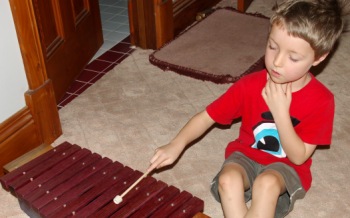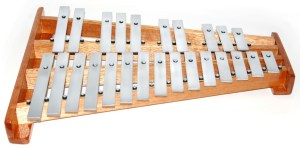MAKING MARIMBAS - Made Easy!
How the Average Handyman can Make Marimbas...
Just Basic Woodworking - Professional Results.
|
On this site you will find...
|
DOWNLOAD MARIMBA MAKING GUIDES P524 Marimba Building Guide (Variable range - 4 to 5 octaves)
|
I design and build BOTH types of marimbas, but my goal is to encourage better quality marimbas. I want to help YOU with better marimba tuning in both bars and resonators - better bar mounting for freely vibrating bars that are secure and don't bounce - Fully chromatic marimbas with professional specifications.
| 1. Pro Concert Marimba | | 2. Mini Marimba | | 3. 3 Octave Baritone/Alto | | 4. Orff Style Xylophones |
About the P524 Concert Marimba
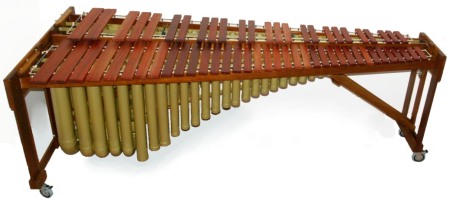 Shown here is the full five-octave version of the P524 Concert Marimba. This goes right down to C2 - that's cello C below the bass stave... so it has the full depth of an African style bass marimba PLUS all the notes on top PLUS it is fully chromatic!
Shown here is the full five-octave version of the P524 Concert Marimba. This goes right down to C2 - that's cello C below the bass stave... so it has the full depth of an African style bass marimba PLUS all the notes on top PLUS it is fully chromatic!
This design is flexible and can be made without the top end so it just becomes a bass marimba... or it can be made with any range at all you like. It is very popular as a basic four octave marimba for student practise or ensembles - or with a different concert range... like the one in the first photo on this page - which is a four octave + 3rd version.
Average cost:... 4 octave version fully finished with purpleheart bars.
Email for Quote and Specifics
Get the P524 Marimba Making Guide Here.
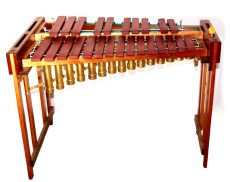 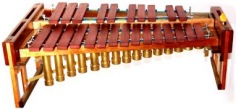
|
About the 2 Octave Mini Marimba
The legs just slide into the body at the ends, so you can have BOTH a stand up height version AND a sit or kneel version. You can even make these interlocking to stack on top of each other for super space saving storage!

Light enough to be caried by a pair of small children.
Big enough to be taken seriously by adults.
Incredibly cheap and quick n' easy to build.
Average cost:... fully finished with purpleheart bars.
Email for Quote and Specifics
Get the P2 Marimba Building Guide Here.
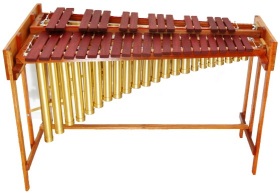
About the 3 Octave Baritone / Alto Marimba
Quick to build design & simple materials, make this a great value marimba.
Average cost:... fully finished with purpleheart bars.
Email for Quote and Specifics
Get the P3 Making Maimbas Guide Here.
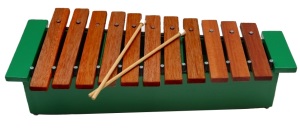
About the Box Resonated Orff Xylophones
Average cost:... fully finished with hardwood tone bars.
Email for Quote and Specifics
Get the P1 Making Xylophones Guide Here.
Making Marimbas - Design Philosophy
- Simple construction techniques and tools. You don't need to be an expert or have a woodworking workshop to build these instruments. Obviously with more experience oyu will likely work faster and produce even better results... but the average handyman can produce good resuls right away.
- Common materials - These marimbas are made with inexpensive and common materials that can usually be found in the average hardware store. Even generic hardwood bars can sound great, and if you really want a professional sound you can use a more particular tonewood like padauk or purpleheart. I can even make bars for you so you guarantee the tuning is perfect - even the overtones!
- Practical frames Construction is solid but lightweight so these marimbas can be easily moved and stand up to the wear & tear of frequent use. Everything can be easily taken apart for road transport.
- Professional sound - There's nothing worse than saving money on a marimba only to have it sound less than 100% professional. Too often I have seen ensemble marimbas with badly tuned bars, bars that clunk or simply don't vibrate as freely as they could, bars that bounce off the frame when played enthusiastically... I never build marimbas that have any of these problems.
Common Marimba Making Questions and Solutions
Answer. - Well it is actually possible to make both marimba frames and marimba bars from just about ANY timber... but some are definitely better suited than others. For frames you want timber that is strong and stable as well as not too expensive. After all it is structural, so it doesn't need to sound good. Any timber that you normally build houses etc from will work well. My favorite is oak. In particular a timber that DOES NOT vibrate very well and sounds a bit dead when struck is better for frames as it tends to reduce sympathetic resonances in the frame. Oak is great for frames as it ticks all those boxes!
Now for bars... you want timber that DOES vibrate well and produces a clear ringing sound. You can of course get SOME tone from any timber at all but there is definitely a difference in the quality of sound. Some timbers are ok for low pitch bars but lose clarity and that ringing quality in the top register - and some are nice and bright but lack oomph in the bottom end. A very FEW timbers work well over a whole concert range instrument.
Of course in addition to the actual sound a bar produces the issue of hardness and of weight can also play a part. Lightweight timbers are not desirable as they have a tendency to bounce when played. Also light timbers tend to be softer. Soft timbers can be ok for very low pitch bars, but are definitely no good for mid to high bars. The problem is you are hitting these bars with mallets and soft timbers will dent and not stand up over time. Cedar is a good example of a timber which has a nice ring in some registers, but would never be suitable because it is just too soft! It is a myth that hardness ALONE makes a timber actually sound good - it is not the case - but you do need a CERTAIN amount of hardness, and the timbers that DO sound good, tend to be harder ones.
Traditionally the number one choice for marimba bars has been Honduras Rosewood (Dalbergia Stevensonii). You can still get it in some parts of the world but it is always among the more expensive timbers. Here in Australia it is no longer being imported at all as it is an endangered species essentially... you certainly can't really get enough for a marimba, and even if you can get small amounts... it is INCREDIBLY expensive. African Padauk has often been used over the last few decades as a tried and trued second best. Many people will say that it does not sound as good but actually I think it sounds every BIT as good - in fact I think it sounds even better in the low end than rosewood does. For a five octave marimba I think that rosewood often has the lowest few bars sounding a little over prevalent in the overtones - although that is being picky. Padauk makes an extremely fine sounding marimba and works across the entire concert range - and it sounds even better than rosewood on bass marimbas. The only issues one can have with padauk - and once again I'm being fussy here - is that the hardness and weight of the timber is sometimes not quite up to task for the top of the range. The small bars can bounce a little if not mounted well, and if you continuously use harder mallets and play the top octave hard, those bars can start to get damaged over time. Padauk comes from a bigger tree and is considerably less expensive than rosewood though - and easier to get. If you use it for a concert marimba, try to use the hardest heaviest planks you can find to make the top notes.
Purpleheart is another favorite timber of mine. I think it is the best possible timber for bass bars. It is certainly harder and heavier than padauk and is a very robust timber - and it LOOKS sensational with its deep rich purple colour. It can work for a full range marimba as well and sound great - the only thing is that sometimes the top octave or so - the higher notes can sound just a fraction lacking. They don't ring QUITE as well or clearly and I would say on average are about 15% less good in the top of the range. Like with padauk, if you select the hardest and best bits you have for the top notes, you can offset this effect a bit. It is exactly this slight suppression of the upper notes that actually leads to the great sound in the bass as the overtones do not stick out too much.

